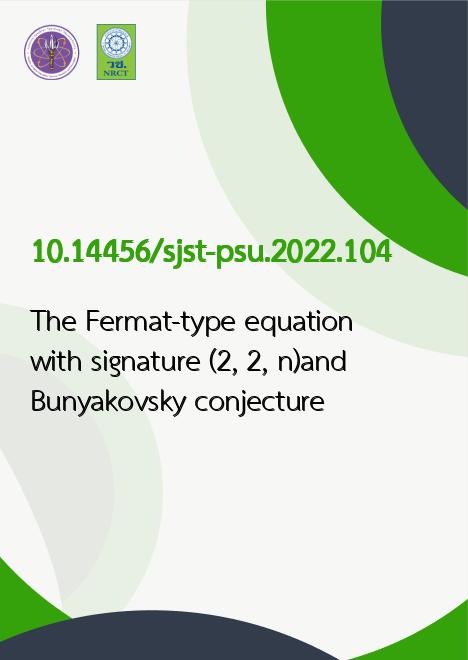
|
The Fermat-type equation with signature (2, 2, n)and Bunyakovsky conjecture |
|---|---|
| รหัสดีโอไอ | |
| Creator | 1. Sawian Jaidee 2. Korakot Saosoong |
| Title | The Fermat-type equation with signature (2, 2, n)and Bunyakovsky conjecture |
| Publisher | Research and Development Office, Prince of Songkla University |
| Publication Year | 2565 |
| Journal Title | Songklanakarin Journal of Science an Technology (SJST) |
| Journal Vol. | 44 |
| Journal No. | 3 |
| Page no. | 779-784 |
| Keyword | fermat- type equations, Gaussian integers, unique factorization, Bunyakovsky conjecture |
| URL Website | https://rdo.psu.ac.th/sjst/index.php |
| ISSN | 0125-3395 |
| Abstract | We first discuss the Fermat-type equation with signature (2, ๐', ๐'), which is the Diophantine equation in the shape ๐'ฅ2 +๐'ฆ๐' = ๐'ง๐', where ๐'ฅ, ๐'ฆ and ๐'ง are unknown integers, and ๐', ๐' are fixed positive integers greater than 1. This kind of equations hasbeen particularly focused on our work here in the case ๐' = 2, ๐' = 5 and ๐'ฆ = ๐' is a fixed rational prime. Then the first resultdescribing the condition of such a prime ๐' in order to illustrate that this certain equation has an integer solution (๐'ฅ, ๐'ฆ) when ๐' โก1(mod 4) and gcd(๐'ฅ, ๐') = 1, and the second result stating that the equation has no integer solution (๐'ฅ, ๐'ฆ) when ๐' โก 3(mod 4) areprovided. Lastly, we will indicate that the results of Be ฬrczes and Pink about solving the equation ๐'ฅ2 + ๐'2๐' = ๐'ง๐'in 2008 havebeen generalized in the particular cases (๐', ๐') = (3,1) and (5,1), and additionally present that the first result and also its analogousresult in the particular case ๐' = 3 can be linked to the Bunyakovsky conjecture. |
